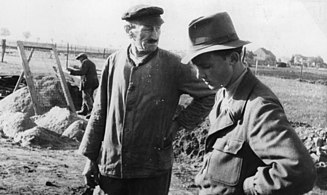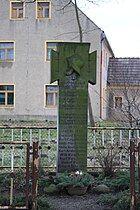Adelsdorf (Lampertswalde)
|
Adelsdorf
Lampertswalde municipality
Coordinates: 51 ° 19 ′ 10 ″ N , 13 ° 34 ′ 58 ″ E
|
|
|---|---|
| Height : | 123 m above sea level NHN |
| Incorporation : | January 1, 1997 |
| Postal code : | 01561 |
| Area code : | 03522 |
Adelsdorf , from 1950 to 1990 the village of youth , is a district of Lampertswalde in the district of Meißen in Saxony . The place is located about five kilometers northeast of the city of Großenhain and six kilometers northwest of Lampertswalde on the county road 8510.
history
Place name and first documentary mention
The first written mention of the place comes from 1266 with the name Adeloldensdorf . The place name is interpreted as the village of an Adalwalt, Adalwolf or Otolf or Adolf . Other spellings of the place name over the centuries were: Otelfestorf, Adeloldesdorf, Adolfsdorf, Adolfestorff, Adilstorff and Adolfisdorf. From 1950 the village was renamed Village of Youth . The place kept this place name until 1990, before it was renamed Adelsdorf again.
Originally laid out as a square village, the location later developed into a street green village . There are only a few known prehistoric finds from the Bronze Age . The size of the village was given at the time of the first mention of eleven hooves and it belonged to Grossenhain Vogt Rulico, who sold it to Grossenhain Magdalenenkloster in 1266 . Around 1406 there were nine Hüfner residents in Adelsdorf.
The church had been parish off to Großenhain since ancient times. The Adelsdorf children first had to attend school in Folbern. Economically, people lived from agriculture. However, the so-called Spitalteich (Spitalteich) was created as early as 1472 to the south-west of the village , a water body of around 20 hectares which was used for fish farming and in 1625 belonged to the Grossenhain office . However, the pond silted up again later.
The Adelsdorf manor
Adelsdorf remained in the possession of the Magdalenenkloster until it was secularized in 1540. Then the local knight's seat was restored and the village was sold to Georg zu Kommerstadt in 1543 . In 1662 Adelsdorf, which suffered severe damage and victims of the plague during the Thirty Years' War, was resident in writing . In the period that followed, there were a few changes of ownership. Mentioned herein Wolfen Gunther von Carlowitz , Ludwig Ernst von Pöllnitz , Frederick William of Beichlingen and others. From 1896 onwards, the Adelsdorf manor and the associated lands were leased by the Reich Military Treasury and managed as a Vorwerk by the Remontedepot in Kalkreuth until it was transferred to the Saxon state in 1920.
The Saxon art historian Cornelius Gurlitt published a short description of the old Adelsdorfer manor in volume 37 (Amtshauptmannschaft Grossenhain (Land)) of his 1914 book Descriptive Representation of the Older Monuments and Art of the Kingdom of Saxony . Accordingly, the mansion was an elongated rectangular building with a hipped roof and a wing with a steep gable protruding towards the farm yard. In the middle of the main roof there was a ridge turret with a Welscher hood , which served as a bell tower . The stable buildings had mansard roofs and the passage to the farm yard had wide basket arch gates.
The "Village of Youth"
Shortly before the end of the Second World War , almost the entire place was the victim of a targeted arson by the Red Army . Before that, on May 1, 1945, seven remaining concentration camp inmates of a prisoner train passing through were shot in the village.
- The destroyed Adelsdorf in 1947
After the war, as part of the land reform in the Soviet occupation zone , the agricultural land belonging to the state estate in Adelsdorf, which had meanwhile emerged from the local manor, was divided and the village, 97 percent of which had been destroyed, was rebuilt. With the support of the district administration and the youth association Free German Youth (FDJ), the aid organization “Village of Youth” was founded, with the young people deployed here helping, among other things, with the construction and repair of the local buildings, as well as agricultural professions on a newly created training farm could learn. More than one hundred houses, stables and barns had been built by the late summer of 1950 with the help of the young people's voluntary and unpaid work, and so on September 1, 1950, Adelsdorf was renamed "Village of Youth". At that time, there was a similar project in Berga bei Schlieben in what is now the Elbe-Elster district , which later fell asleep.
Just two years later, the first agricultural production cooperative (LPG) was founded in 1952 . In 1960 two more agricultural production cooperatives were added. All three cooperatives were later assigned to the LPG in Lampertswalde.
In October 1990, during the fall of the Wall , there was finally a public survey in the town and after forty years the town was given its old name of Adelsdorf again . On January 1, 1997, it was incorporated into Lampertswalde.
- Adelsdorf in 1950
Visit of the Saxon Prime Minister Max Seydewitz
Culture and sights
Monuments
Several historical monuments and buildings are recorded in the local list of monuments.
At Eichenstraße 23 there is a three-sided courtyard with a residential building, stable extension and barn that was built around 1920 and is a listed building . It has a local historical significance for the reconstruction of the place after the Second World War, as it is the teaching farm established around 1950. The house, built in the local style, is a two-story plastered building with a crooked hip roof , a rounded entrance area and a wooden upper arbor gallery . The commercial annex adjoins the house on the left and is single-storey and, like the barn of the farm, has a gable roof.
The remains of a Dutch windmill tower built in 1856 are also under monument protection . These are located on the bypass road in the direction of Folbern. A transformer house , which was built in the first half of the 20th century and is now a listed building, can be found nearby .
A memorial to the fallen from 1922 commemorates the villagers who died in World War I , another one to the seven concentration camp inmates who were shot in May 1945. Finally, a memorial integrated into an honorary grove commemorates the reconstruction of the village after the Second World War.
Club life
In addition to the volunteer fire brigade , active clubs in the village include the Adelsdorfer Heimatverein and the Adelsdorfer Dumperteam .
Fire station of the volunteer fire brigade
literature
- Dietrich Hanspach, Haik Thomas Porada: Grossenhainer care. A regional study of the area around Großenhain and Radeburg . Ed .: Institute for Regional Geography Leipzig and the Saxon Academy of Sciences in Leipzig. Böhlau Verlag, Cologne, Weimar, Vienna 2008, ISBN 978-3-412-09706-6 , pp. 95-97 .
- Otto Mörtzsch: Historical-topographical description of the administrative authority in Großenhain . Regional Association of Saxon Homeland Security , Dresden 1935.
Web links
- Adelsdorf (Lampertswalde) in the Digital Historical Directory of Saxony
- Website of the municipality of Lampertswalde
Notes and individual references
- ↑ a b c d e f g h i j k l m Dietrich Hanspach, Haik Thomas Porada: Grossenhainer Pflege. A regional study of the area around Großenhain and Radeburg . Ed .: Institute for Regional Geography Leipzig and the Saxon Academy of Sciences in Leipzig. Böhlau Verlag, Cologne, Weimar, Vienna 2008, ISBN 978-3-412-09706-6 , pp. 95-97 .
- ↑ a b c d e f g h Waltraud Krille: 750 years of Adelsdorf in Gemeindeblatt - Announcements and information for the citizens of the communities of Lampertswalde and Schönfeld , January 31, 2016
- ↑ a b c d Adelsdorf (Lampertswalde) in the Digital Historical Directory of Saxony , accessed on December 8, 2017
- ↑ a b c d e f Otto Mörtzsch: Historical-topographical description of the administrative authority in Großenhain . Regional Association of Saxon Homeland Security , Dresden 1935.
- ↑ Cornelius Gurlitt: Amtshauptmannschaft Grossenhain (country) . Dresden 1914, p. 1 .
- ↑ Kathrin Krüger-Mlaouhia: Mayor's memories in “Adlich” in Sächsische Zeitung , May 2, 2016
- ^ "Activists build a village for the youth" in Berliner Zeitung , November 24, 1948, page 2
- ↑ "Berga and the village of youth - 1947 to 1949" ( Memento of the original from March 4, 2016 in the Internet Archive ) Info: The archive link has been inserted automatically and has not yet been checked. Please check the original and archive link according to the instructions and then remove this notice. , private homepage, accessed December 8, 2017
- ^ StBA: Changes in the municipalities in Germany, see 1997
- ↑ a b c d List of monuments of the State of Saxony , accessed on December 8, 2017.
- ↑ Associations and clubs in the municipality of Lampertswalde ( Memento of the original dated December 9, 2017 in the Internet Archive ) Info: The archive link was inserted automatically and has not yet been checked. Please check the original and archive link according to the instructions and then remove this notice. , accessed December 9, 2017











